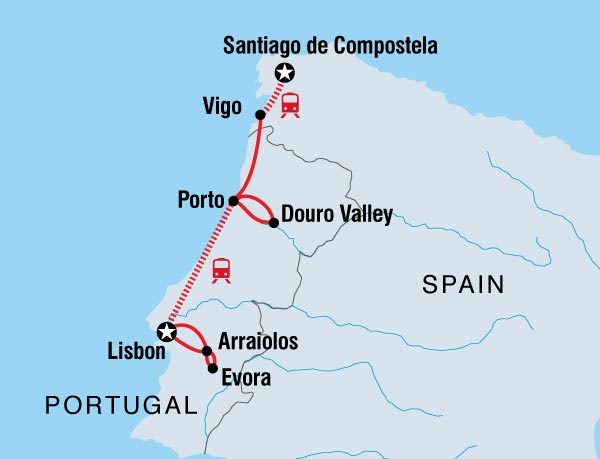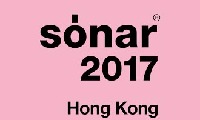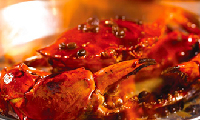|
Buffet: Galaxy Macau Festiva Buffet Macau Tower 360 Cafe Buffet, Portuguese Buffet Travel in Macau:Studio City Golden Reel, Batman Dark Flight, Macau Tower For other traditions of celebrating the Lunar New Year, see Lunar New Year (disambiguation). For the 1991 Chinese film, see The Spring Festival.
|
|
| Spring Festival | |
|---|---|
| Simplified Chinese | 春 节 |
| Literal meaning | Spring Festival |
Chinese New Year is an important Chinese festival celebrated at the turn of the lunisolar Chinese calendar. It is also known as the Spring Festival, the literal translation of the modern Chinese name. Celebrations traditionally run from the eve to the Lantern Festival on the 15th day of the first calendar month, making it one of the longest celebrated festivals. The first day of the New Year falls on some day between 21 January and 20 February.
The Chinese Lunar Year is centuries old and gains significance because of several myths and traditions. Traditionally, the festival was a time to honour deities as well as ancestors. Chinese New Year is celebrated in countries and territories with significant Chinese populations, including Mainland China, Hong Kong, Macau, Taiwan, Singapore, Thailand, Cambodia, Indonesia, Malaysia, Mauritius, and the Philippines. Chinese New Year is considered a major holiday for the Chinese and has had influence on the lunar new year celebrations of its geographic neighbours.
Within China, regional customs and traditions concerning the celebration of the Chinese New Year vary widely. Often, the evening preceding Chinese New Year's Day is an occasion for Chinese families to gather for the annual reunion dinner. It is also traditional for every family to thoroughly cleanse the house, in order to sweep away any ill-fortune and to make way for good incoming luck. Windows and doors will be decorated with red color paper-cuts and couplets with popular themes of "good fortune" or "happiness", "wealth", and "longevity." Other activities include lighting firecrackers and giving money in red paper envelopes.
Although the Chinese calendar traditionally does not use continuously numbered years, outside China its years are often numbered from the reign of the 3rd millennium BCE Yellow Emperor. But at least three different years numbered 1 are now used by various scholars, making the year beginning CE 2015 the "Chinese year" 4713, 4712, or 4652.
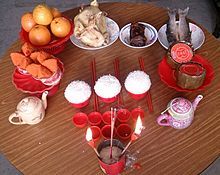
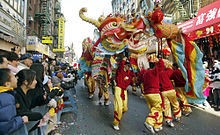
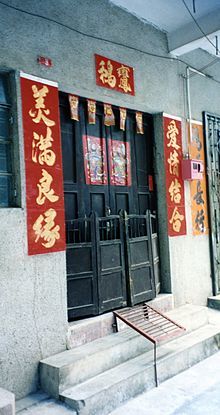
##Names in Chinese
The festivities surrounding Chinese New Year were known as the Nian festival (Chinese: 年节; pinyin: Nián Jié), which may be understood as "Festival of the Year", or "New Year Festival". A derivative term, Guo Nian (traditional Chinese: 過年; simplified Chinese: 过年; pinyin: guò Nián; literally: "to pass the year"), is still commonly used to refer to the act of celebrating the arrival of the new year. An alternative name for Chinese New Year is "New Year in the Agricultural Calendar" (Chinese: 阴历新年; pinyin: Nónglì Xīnnían), the "Agricultural Calendar" being one of the more common Chinese language names for the Chinese calendar in China.
New Year's Day itself was traditionally named Yuandan (Chinese: 元旦; pinyin: Yuándàn), literally "the first sunrise", but in 1913 the recently established Republic of China government appropriated that name to refer instead to New Year's Day in the newly adopted Gregorian Calendar, with Chinese New Year instead being called "Spring Festival" (Chinese: 春节; pinyin: Chūnjié), which remains the official name for the New Year's Day public holiday in both mainland China and Taiwan. Now, Yuandan refers to the first day of one year according to solar calendar and it is the same day with western New Year's Day in spite of the time difference. Prior to 1913, "Spring Festival" instead referred to lichun, ( 4 or 5 February), the first solar term in a Chinese calendar year, which marked the end of winter and start of spring.
An alternative name for Chinese New Year's Day means literally "the first day of the (great) year" (Chinese: (大)年月朔; pinyin: (Dà) Nián Chūyī). The New Year's Day public holiday in Hong Kong and Macau is named in Chinese, as literally "First Day of the Year in the Agricultural Calendar" (Chinese: 阴历年月朔; pinyin: Nónglì Nián Chūyī) while the official English name is "The First Day of Lunar New Year".
Chinese New Year's Eve, a day where Chinese families gather for their annual reunion dinner, named as Nian Ye Fan, is known as "Evening of the Passing" (Chinese: 大年节; pinyin: Chúxī).
##Dates in Lunar Calendar
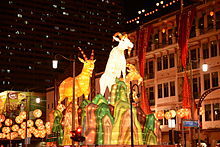
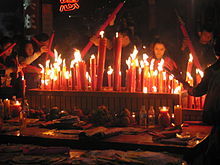
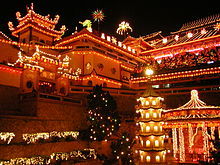
The lunisolar Chinese calendar determines the date of Chinese New Year. The calendar is also used in countries that have been influenced by, or have relations with, China - such as Korea, Japan and Vietnam.
In the Gregorian calendar, Chinese New Year falls on different dates each year, a date between 21 January and 20 February. In the Chinese calendar, winter solstice must occur in the 11th month, which means that Chinese New Year usually falls on the second new moon after the winter solstice (rarely the third if an intercalary month intervenes). In traditional Chinese Culture, lichun is a solar term marking the start of spring, which occurs about 4 or 5 February, which is the median date of Chinese New Year's Day. To determine whether a year has an intercalary month, one only needs to check whether Chinese New Year is within the month of January.[citation needed]
The dates for Chinese New Year from 1912 to 2101 (in the Gregorian calendar) are below, along with the year's presiding animal zodiac and its Stem-branch. In general, Chinese New Year follows the Metonic cycle, and returns to the same date in Gregorian calendar roughly.The names of the Earthly Branches have no English counterparts and are not the Chinese translations of the animals. Alongside the 12-year cycle of the animal zodiac there is a 10-year cycle of heavenly stems. Each of the ten heavenly stems is associated with one of the five elements of Chinese astrology, namely: Wood, Fire, Earth, Metal, and Water. The elements are rotated every two years while a yin and yang association alternates every year. The elements are thus distinguished: Yang Wood, Yin Wood, Yang Fire, Yin Fire, etc. These produce a combined cycle that repeats every 60 years. For example, the year of the Yang Fire Rat occurred in 1936 and in 1996, 60 years apart.
Many people inaccurately calculate their Chinese birth-year by converting it from their Gregorian birth-year. As the Chinese New Year starts in late January to mid-February, the previous Chinese year dates through 1 January until that day in the new Gregorian year, remaining unchanged from the previous Gregorian year. For example, the 1989 year of the Snake began on 6 February 1989. The year 1990 is generally aligned with the year of the Horse. However, the 1989 year of the Snake officially ended on 8 February 1990. This means that anyone born from 1 January to 7 February 1990 was actually born in the year of the Snake rather than the year of the Horse. Many online Chinese Sign calculators do not account for the non-alignment of the two calendars, using Gregorian-calendar years rather than official Chinese New Year dates.[citation needed]
One scheme of continuously numbered Chinese-calendar years assigns 4709 to the year beginning, 2011, but this is not universally accepted; the calendar is traditionally cyclical, not continuously numbered.
##Mythology
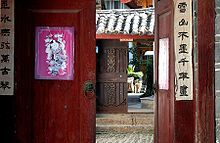
According to tales and legends, the beginning of the Chinese New Year started with a mythical beast called the Nian. Nian would eat villagers, especially children. To protect themselves, the villagers would put food in front of their doors at the beginning of every year. It was believed that after the Nian ate the food they prepared, it wouldn't attack any more people. One day, a villager decided to get revenge on the Nian. A god visited him and told him to put red paper on his house and to place firecrackers. The villagers then understood that the Nian was afraid of the color red. When the New Year was about to come, the villagers would wear red clothes, hang red lanterns, and red spring scrolls on windows and doors. People also used firecrackers to frighten away the Nian. From then on, Nian never came to the village again. The Nian was eventually captured by Hongjun Laozu, an ancient Taoist monk. The Nian became Hongjun Laozu's mount.
##Public holiday
Chinese New Year is observed as a public holiday in a number of countries and territories where a sizable Chinese population resides. Since Chinese New Year falls on different dates on the Gregorian calendar every year on different days of the week, some of these governments opt to shift working days in order to accommodate a longer public holiday. In some countries, a statutory holiday is added on the following work day when the New Year falls on a weekend, as in the case of 2013, where the New Year's Eve (9 February) falls on Saturday and the New Year's Day (10 February) on Sunday.
Depending on the country, the holiday may be termed differently; common names are "Chinese New Year", "Lunar New Year", "New Year Festival", and "Spring Festival". For New Year celebrations that are lunar but not based on the Chinese New Year (such as Korea's Seollal and Vietnam's Tết), see the article on Lunar New Year.
For the other countries (likewise North America, South America, Europe and Oceania), the number of days for CNY varies from 3 days to 15 days, the highest number is for the United States. The worst is not having a public holiday at all.
##Festivities
Preceding days
On the eighth day of the lunar month prior to Chinese New Year, the Laba holiday (simplified Chinese: 腊八; traditional Chinese: 臘八; pinyin: làbā), a traditional porridge, Laba porridge (simplified Chinese: 腊八粥; traditional Chinese: 臘八粥; pinyin: làbā zhōu), is served in remembrance of an ancient festival, called La, that occurred shortly after the winter solstice. Pickles such as Laba garlic, which turns green from vinegar, are also made on this day. For those that believe in Buddhism, the Laba holiday is also considered Bodhi Day. Layue (simplified Chinese: 尾月; traditional Chinese: 臘月; pinyin: Làyuè) is a term often associated with Chinese New Year as it refers to the sacrifices held in honor of the gods in the twelfth lunar month, hence the cured meats of Chinese New Year are known as larou (simplified Chinese: 腊肉; traditional Chinese: 臘肉; pinyin: làròu). The porridge was prepared by the women of the household at first light, with the first bowl offered to the family's ancestors and the household deities. Every member of the family was then served a bowl, with leftovers distributed to relatives and friends. It's still served as a special breakfast on this day in some Chinese homes. The concept of the 'La month' is similar to Advent in Christianity. Many families eat vegetarian on Chinese New Year eve, the garlic and preserved meat are eaten on Chinese New Year day.
On the days immediately before the New Year celebration, Chinese families give their homes a thorough cleaning. There is a Cantonese saying "Wash away the dirt on nin ya baat" (Chinese: 年廿八,洗肮脏; pinyin: nián niàn bā, xǐ lātà; Jyutping: nin4 jaa6 baat3, sai2 laap6 taap3 (laat6 taat3)), but the practice is not restricted to nin ya baat (the 28th day of month 12). It is believed the cleaning sweeps away the bad luck of the preceding year and makes their homes ready for good luck. Brooms and dust pans are put away on the first day so that the newly arrived good luck cannot be swept away. Some people give their homes, doors and window-frames a new coat of red paint; decorators and paper-hangers do a year-end rush of business prior to Chinese New Year. Homes are often decorated with paper cutouts of Chinese auspicious phrases and couplets. Purchasing new clothing and shoes also symbolize a new start. Any hair cuts need to be completed before the New Year, as cutting hair on New Year is considered bad luck due to the homonymic nature of the word "hair" (fa) and the word for "prosperity". Businesses are expected to pay off all the debts outstanding for the year before the new year eve, extending to debts of gratitude. Thus it is a common practice to send gifts and rice to close business associates, and extended family members.
In many households where Buddhism or Taoism is prevalent, home altars and statues are cleaned thoroughly, and decorations used to adorn altars over the past year are taken down and burned a week before the new year starts, to be replaced with new decorations. Taoists (and Buddhists to a lesser extent) will also "send gods" (Chinese: 送神; pinyin: sòngshén), an example would be burning a paper effigy of Zao Jun the Kitchen God, the recorder of family functions. This is done so that the Kitchen God can report to the Jade Emperor of the family household's transgressions and good deeds. Families often offer sweet foods (such as candy) in order to "bribe" the deities into reporting good things about the family.
Prior to the Reunion Dinner, a prayer of thanksgiving is held to mark the safe passage of the previous year. Confucianists take the opportunity to remember their ancestors, and those who had lived before them are revered. Some people do not give a Buddhist prayer due to the influence of Christianity, with a Christian prayer offered instead.
The biggest event of any Chinese New Year's Eve is the Reunion Dinner, named as "Nian Ye Fan". A dish consisting of special meats is served at the tables of Chinese families, as a main course for the dinner and offering for the New Year. This meal is comparable to Thanksgiving dinner in the U.S. and remotely similar to Christmas dinner in other countries with a high percentage of Christians. In northern China, it is customary to make dumplings (jiaozi) after dinner to eat around midnight. Dumplings symbolize wealth because their shape resembles a Chinese sycee. By contrast, in the South, it is customary to make a glutinous new year cake (niangao) and send pieces of it as gifts to relatives and friends in the coming days of the new year. Niángāo [Pinyin] literally means "new year cake" with a homophonous meaning of "increasingly prosperous year in year out". After dinner, some families go to local temples hours before the new year begins to pray for a prosperous new year by lighting the first incense of the year; however in modern practice, many households hold parties and even hold a countdown to the new year. Traditionally, firecrackers were once lit to scare away evil spirits with the household doors sealed, not to be reopened until the new morning in a ritual called "opening the door of fortune" (simplified Chinese: 开财门; traditional Chinese: 開財門; pinyin: kāicáimén). Beginning in 1982, the CCTV New Year's Gala was broadcast four hours before the start of the New Year.
First day
The first day is for the welcoming of the deities of the heavens and earth, officially beginning at midnight. It is a traditional practice to light fireworks, burn bamboo sticks and firecrackers and to make as much of a din as possible to chase off the evil spirits as encapsulated by nian (Chinese: 年) of which the term guo nian (simplified Chinese: 过年; traditional Chinese: 過年; pinyin: guònián) was derived. Many people, especially Buddhists, abstain from meat consumption on the first day because it is believed that this will ensure longevity for them. Some consider lighting fires and using knives to be bad luck on New Year's Day, so all food to be consumed is cooked the days before. On this day, it is considered bad luck to use the broom.
Most importantly, the first day of Chinese New Year is a time to honor one's elders and families visit the oldest and most senior members of their extended families, usually their parents, grandparents and great-grandparents.
For Buddhists, the first day is also the birthday of Maitreya Bodhisattva (better known as the more familiar Budai Luohan), the Buddha-to-be. People also abstain from killing animals.

Some families may invite a lion dance troupe as a symbolic ritual to usher in the Chinese New Year as well as to evict bad spirits from the premises. Members of the family who are married also give red envelopes containing cash known as lai see or angpow, a form of blessings and to suppress the aging and challenges associated with the coming year, to junior members of the family, mostly children and teenagers. Business managers also give bonuses through red packets to employees for good luck, smooth-sailing, good health and wealth.
While fireworks and firecrackers are traditionally very popular, some regions have banned them due to concerns over fire hazards. For this reason, various city governments (e.g., Hong Kong, Beijing, for a number of years) issued bans over fireworks and firecrackers in certain precincts of the city. As a substitute, large-scale fireworks display have been launched by governments in such cities as Hong Kong and Singapore.
Second day

The second day of the Chinese New Year, known as "beginning of the year" (simplified Chinese: 开年; traditional Chinese: 開年; pinyin: kāinián), was when married daughters visited their birth parents, relatives and close friends. (Traditionally, married daughters didn't have the opportunity to visit their birth families frequently.)
During the days of imperial China, "beggars and other unemployed people circulate[d] from family to family, carrying a picture [of the God of Wealth] shouting, "Cai Shen dao!" [The God of Wealth has come!]." Householders would respond with "lucky money" to reward the messengers. Business people of the Cantonese dialect group will hold a 'Hoi Nin' prayer to start their business on the 2nd day of Chinese New Year so they will be blessed with good luck and prosperity in their business for the year.
As this day is believed to be The Birthday of Che Kung, a deity worshipped in Hong Kong, worshippers go to Che Kung Temples to pray for his blessing. A representative from the government asks Che Kung about the city's fortune through kau cim.
Some believe that the second day is also the birthday of all dogs and remember them with special treats.
Third day
The third day is known as "red mouth" (Chinese: 赤口; pinyin: Chìkǒu). Chikou is also called "Chigou's Day" (Chinese: 赤狗日; pinyin: Chìgǒurì). Chigou, literally "red dog", is an epithet of "the God of Blazing Wrath" (Chinese: 熛怒之神; pinyin: Biāo nù zhī shén). Rural villagers continue the tradition of burning paper offerings over trash fires. It is considered an unlucky day to have guests or go visiting. Hakka villagers in rural Hong Kong in the 1960s called it the Day of the Poor Devil and believed everyone should stay at home. This is also considered a propitious day to visit the temple of the God of Wealth and have one's future told.
Fourth day
In those communities that celebrate Chinese New Year for 15 days, the fourth day is when corporate "spring dinners" kick off and business returns to normal. Other areas that have a longer Chinese New Year holiday will celebrate and welcome the gods in this day.
Fifth day
This day is the god of Wealth's birthday. In northern China, people eat jiaozi, or dumplings, on the morning of powu (Chinese: 破五; pinyin: pòwǔ). In Taiwan, businesses traditionally re-open on the next day (the sixth day), accompanied by firecrackers.
It is also common in China that on the 5th day people will shoot off firecrackers to get Guan Yu's attention, thus ensuring his favor and good fortune for the new year.
Seventh day
The seventh day, traditionally known as Renri (the common person's birthday), is the day when everyone grows one year older. In some overseas Chinese communities in Southeast Asia, such as Malaysia and Singapore, it is also the day when tossed raw fish salad, yusheng, is eaten for continued wealth and prosperity.
For many Chinese Buddhists, this is another day to avoid meat, the seventh day commemorating the birth of Sakra, lord of the devas in Buddhist cosmology who is analogous to the Jade Emperor.
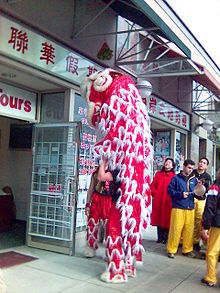
Eighth day
Another family dinner is held to celebrate the eve of the birth of the Jade Emperor, the ruler of heaven. People normally return to work by the eighth day, therefore the Store owners will host a lunch/dinner with their employees, thanking their employees for the work they have done for the whole year.
Approaching 12 midnight on this day, Hokkien people prepare for the "Jade Emperor ritual" (Hokkien: 拜天公 Pài Thiⁿ-kong) during which incense is burnt and food offerings made to the Jade Emperor and also to Zao Jun, the Kitchen god who reports on each family to the Jade Emperor.
Some people will hold a ritual prayer after midnight on the eighth day. In Malaysia, especially, people light fireworks, often more than on the first day.
This practice of Bai Ti Gong can also be seen in Singapore.
Ninth day
The ninth day of the New Year is a day for Chinese to offer prayers to the Jade Emperor of Heaven in the Daoist Pantheon. The ninth day is traditionally the birthday of the Jade Emperor. This day, called Ti Kong Dan (Hokkien: 天公诞 Thiⁿ-kong Tan), Ti Kong Si (Hokkien: 天公生 Thiⁿ-kong Siⁿ) or Pai Ti Kong (Hokkien: 拜天公 Pài Thiⁿ-kong), is especially important to Hokkiens, even more important than the first day of the Chinese New Year.
Come midnight of the eighth day of the new year, Hokkiens will offer thanks to the Emperor of Heaven. A prominent requisite offering is sugarcane. Legend holds that the Hokkien were spared from a massacre by Japanese pirates by hiding in a sugarcane plantation during the eighth and ninth days of the Chinese New Year, coinciding with the Jade Emperor's birthday. Since "sugarcane" (Hokkien: 甘蔗 kam-chià) is a near homonym to "thank you" (Hokkien: 感激 kám-siā) in the Hokkien dialect, Hokkiens offer sugarcane on the eve of his birthday, symbolic of their gratitude.
In the morning of this birthday (traditionally anytime from midnight to 7am), Taiwanese households set up an altar table with 3 layers: one top (containing offertories of six vegetables (Chinese: 六斋; pinyin: liù zhāi), noodles, fruits, cakes, tangyuan, vegetable bowls, and unripe betel, all decorated with paper lanterns) and two lower levels (containing the five sacrifices and wines) to honor the deities below the Jade Emperor. The household then kneels three times and kowtows nine times to pay obeisance and wish him a long life.
Incense, tea, fruit, vegetarian food or roast pig, and gold paper is served as a customary protocol for paying respect to an honored person.
Tenth day
The Jade Emperor's party is celebrated on this day.
Thirteenth day
On the 13th day people will eat pure vegetarian food - in the belief that it will clean out their stomachs - due to consuming too much food over the preceding two weeks.
This day is dedicated to the General Guan Yu, also known as the Chinese God of War. Guan Yu was born in the Han dynasty and is considered the greatest general in Chinese history. He represents loyalty, strength, truth, and justice. According to history, he was tricked by the enemy and was beheaded.
Almost every organization and business in China will pray to Guan Yu on this day. Before his life ended, Guan Yu had won over one hundred battles and that is a goal that all businesses in China want to accomplish. In a way, people look at him as the God of Wealth or the God of Success.
Fifteenth day
The fifteenth day of the new year is celebrated as "Yuanxiao Festival" (simplified Chinese: 元宵节; traditional Chinese: 元宵節; pinyin: Yuán xiāo jié), also known as "Shangyuan Festival" (simplified Chinese: 上元节; traditional Chinese: 上元節; pinyin: Shàng yuán jié) or the Lantern Festival (otherwise known as Chap Goh Mei Chinese: 十五暝; pinyin: Shíwǔmíng; literally: "the fifteen night" in Fujian dialect). Rice dumplings tangyuan (simplified Chinese: 汤圆; traditional Chinese: 湯圓; pinyin: tang yuán), a sweet glutinous rice ball brewed in a soup, are eaten this day. Candles are lit outside houses as a way to guide wayward spirits home. This day is celebrated as the Lantern Festival, and families walk the street carrying lighted lanterns.
In China, Malaysia and Singapore, this day is celebrated by individuals seeking for a romantic partner, akin to Valentine's Day. Normally, single women would write their contact number on mandarin oranges and throw it in a river or a lake while single men would collect them and eat the oranges. The taste is an indication of their possible love: sweet represents a good fate while sour represents a bad fate.
This day often marks the end of the Chinese New Year festivities.
##Traditional food
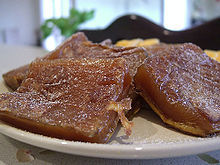
A reunion dinner, named as "Nian Ye Fan", is held on New Year's Eve during which family members gather for celebration. The venue will usually be in or near the home of the most senior member of the family. The New Year's Eve dinner is very large and sumptuous and traditionally includes dishes of meat (namely, pork and chicken) and fish. Most reunion dinners also feature a communal hot pot as it is believed to signify the coming together of the family members for the meal. Most reunion dinners (particularly in the Southern regions) also prominently feature specialty meats (e.g. wax-cured meats like duck and Chinese sausage) and seafood (e.g. lobster and abalone) that are usually reserved for this and other special occasions during the remainder of the year. In most areas, fish (traditional Chinese: 魚; simplified Chinese: 鱼; pinyin: yú) is included, but not eaten completely (and the remainder is stored overnight), as the Chinese phrase "may there be surpluses every year" (traditional Chinese: 年年有餘; simplified Chinese: 年年有余; pinyin: niánnián yǒu yú) sounds the same as "let there be fish every year." Eight individual dishes are served to reflect the belief of good fortune associated with the number. If in the previous year a death was experienced in the family, seven dishes are served.
Red packets for the immediate family are sometimes distributed during the reunion dinner. These packets often contain money in certain numbers that reflect good luck and honorability. Several foods are consumed to usher in wealth, happiness, and good fortune. Several of the Chinese food names are homophones for words that also mean good things.
Like many other New Year dishes, certain ingredients also take special precedence over others as these ingredients also has similar sounding names with prosperity, good luck, or even counting money.
##Practices
History
In 1928, the ruling Kuomintang party in China decreed that Chinese New Year will fall on 1 Jan of the Gregorian Calendar, but this was abandoned due to overwhelming opposition from the populace. In 1967 during the Cultural Revolution, Chinese New Year celebrations were banned in China. The State Council of the People's Republic of China announced that the public should "Change Customs", have a "revolutionized and fighting Spring Festival", and since people needed to work on Chinese New Year Eve, they didn't have holidays during Spring Festival day. The celebrations were reinstated 13 years later after the Chinese economic reform.
Red envelopes


Traditionally, red envelopes or red packets (Cantonese: lai sze or lai see; 利是, 就手 or 利事; Pinyin: lìshì; Mandarin: hóngbāo 红包; Hokkien: ang pow; POJ: âng-pau; Hakka: fung bao) are passed out during the Chinese New Year's celebrations, from married couples or the elderly to unmarried juniors. It is also common for adults or young couples to give red packets to children.
During this period, red packets are also known as 壓歲錢/压岁钱 (yàsuìqián, which was evolved from 壓祟錢/压祟钱, literally, "the money used to suppress or put down the evil spirit").
Red packets almost always contain money, usually varying from a couple of dollars to several hundred. Per custom, the amount of money in the red packets should be of even numbers, as odd numbers are associated with cash given during funerals (帛金: báijīn). The number 8 is considered lucky (for its homophone for "wealth"), and $8 is commonly found in the red envelopes in the US. The number six (六, liù) is also very lucky as it sounds like "smooth" (流, liú), in the sense of having a smooth year. The number four (四)is the worst because its homophone is "death" (死).Sometimes chocolate coins are found in the red packets.
Odd and even numbers are determined by the first digit, rather than the last. Thirty and fifty, for example, are odd numbers, and are thus appropriate as funeral cash gifts. However, it is common and quite acceptable to have cash gifts in a red packet using a single bank note – with ten or fifty yuan bills used frequently. It is customary for the bills to be brand new printed money. Everything regarding the New Year has to be new in order to have good luck and fortune.
The act of asking for red packets is normally called (Mandarin): 讨紅包 tǎo-hóngbāo, 要利是 or (Cantonese): 逗利是. A married person would not turn down such a request as it would mean that he or she would be "out of luck" in the new year. Red packets are generally given by established married couples to the younger non-married children of the family. It is custom and polite for children to wish elders a happy new year and a year of happiness, health and good fortune before accepting the red envelope. Red envelopes are then kept under the pillow and slept on for seven nights after Chinese New Year before opening because that symbolizes good luck and fortune.
In Taiwan in 2000s, some employers also gave red packets as a bonus to maids, nurses or domestic workers from Southeast Asian countries, although whether this is appropriate is controversial.
The Japanese have a similar tradition of giving money during the New Year, called Otoshidama.
Gift exchange
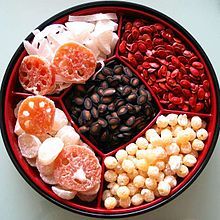
In addition to red envelopes, which are usually given from older people to younger people, small gifts (usually food or sweets) are also exchanged between friends or relatives (of different households) during Chinese New Year. Gifts are usually brought when visiting friends or relatives at their homes. Common gifts include fruits (typically oranges, and never pears), cakes, biscuits, chocolates, and candies.
Certain items should not be given, as they are considered taboo. Taboo gifts include:
- items associated with funerals (example: handkerchiefs, towels, chrysanthemums, items colored white and black)
- items that show time is running out (examples: clocks and watches)
- sharp objects that symbolize cutting a tie (examples: scissors and knives)
- items that show you want to walk away from the relationship (examples: shoes and sandals)
- mirrors
- homonyms for unpleasant topics (examples: "clock" sounds like "the funeral ritual", green hats because "wear a green hat" sounds like "cuckold", "handkerchief" sounds like "goodbye", "pear" sounds like "separate", and "umbrella" sounds like "closing" or "fall").
Markets
Markets or village fairs are set up as the New Year is approaching. These usually open-air markets feature new year related products such as flowers, toys, clothing, and even fireworks. It is convenient for people to buy gifts for their new year visits as well as their home decorations. In some places, the practice of shopping for the perfect plum tree is not dissimilar to the Western tradition of buying a Christmas tree.
Hong Kong filmmakers also release "New Year celebration films" (賀歲片), mostly comedies, in this time of the year.
Fireworks

Bamboo stems filled with gunpowder that were burnt to create small explosions were once used in ancient China to drive away evil spirits. In modern times, this method has eventually evolved into the use of firecrackers during the festive season. Firecrackers are usually strung on a long fused string so it can be hung down. Each firecracker is rolled up in red papers, as red is auspicious, with gunpowder in its core. Once ignited, the firecracker lets out a loud popping noise and, as they are usually strung together by the hundreds, the firecrackers are known for their deafening explosions that are thought to scare away evil spirits. The burning of firecrackers also signifies a joyful time of year and has become an integral aspect of Chinese New Year celebrations.
Firecracker ban
The use of firecrackers, although a traditional part of celebration, has over the years led to many unfortunate outcomes. There have been reported incidents every year of users of fireworks being blinded, losing body parts, or suffering other grievous injuries, especially during the Chinese New Year season. Hence, many governments and authorities eventually enacted laws completely banning the use of firecrackers privately, primarily because of safety issues.
- Taiwan – Beginning 2008, firecrackers are banned in urban areas, but still allowed in rural areas.
- Mainland China – As of 2008, most urban areas in mainland China permit firecrackers. In the first three days of the traditional New Year, it is a tradition that people compete with each other by playing with firecrackers. However, many urban areas banned them in the 1990s. For example, they were banned in Beijing's urban districts from 1993 to 2005. In 2004, 37 people were killed in a stampede when four million people gathered for a rumoured Lantern Festival firework display in nearby Miyun. Since the ban was lifted, the firecracker barrage has been tremendous. In Beijing, firecrackers are typically not allowed inside the 5th ring road. But this is overlooked by authorities for the holiday, provided there are no government buildings nearby; some residents in major cities look down on street-level fireworks from their tower blocks. Bans are rare in rural areas.
- Vietnam – 1996, fireworks were banned across the country because of its dangers.
- Hong Kong – Fireworks are banned for security reasons – some speculate a connection between firework use and the 1967 Leftist Riot. However, the government would put on a fireworks display in Victoria Harbour on the second day of the Chinese New Year for the public. Similar displays are also held in many other cities in and outside China.
- Singapore – a partial ban on firecrackers was imposed in March 1970 after a fire killed six people and injured 68. This was extended to a total ban in August 1972, after an explosion that killed two people and an attack on two police officers attempting to stop a group from letting off firecrackers in February 1972. As a result of this ban, the Chingay Parade was set up to preserve the spirit and culture. However, in 2003, the government allowed firecrackers to be set off during the festive season. At the Chinese New Year light-up in Chinatown, at the stroke of midnight on the first day of the Chinese New Year, firecrackers are set off under controlled conditions by the Singapore Tourism Board with assistance from demolition experts from the Singapore Armed Forces. Other occasions where firecrackers are allowed to be set off are determined by the tourism board or other government organizations. However, they are not allowed to be commercially sold.
- Malaysia – firecrackers are banned for the similar reasons as in Singapore. However, many Malaysians manage to smuggle them from Thailand and the Philippines to meet their private needs.
- Indonesia – Firecrackers and fireworks are forbidden in public during the Chinese New Year, especially in areas with significant non-Chinese population in order to avoid any conflict between the two. However, there were some exceptions. The usage of firecrackers is legal in some metropolitan areas such as Jakarta and Medan, where the degree of racial and cultural tolerance is higher.
- United States – In 2007, New York City lifted its decade-old ban on firecrackers, allowing a display of 300,000 firecrackers to be set off in Chinatown's Chatham Square. Under the supervision of the fire and police departments, Los Angeles regularly lights firecrackers every New Year's Eve, mostly at temples and the shrines of benevolent associations. The San Francisco Chinese New Year Parade, the largest outside China, is accompanied by numerous firecrackers, both officially sanctioned and illicit.
- Australia – Australia, except the Northern Territory, does not allow use of fireworks at all, except when used by a licensed pyrotechnician. These rules also need a permit from local government, and from any relevant local bodies such as maritime or aviation authorities (as relevant to the types of fireworks being used) and hospitals, schools, etc., within a certain range.
- Philippines - Despite the rise in firecracker-related injuries in 2009, the Department of Health has acknowledged that a total ban on firecrackers in the country will be hard to implement. Davao City, the first city in the country to impose a firecracker ban, has enjoyed injury-free celebrations for at least the last 11 years. Their ban has been in effect since 2002.
Music
"Happy New Year!" (Chinese: 新年好呀; pinyin: Xīn Nián Hǎo Ya; literally: "New Year's Good, Ya") is a popular children’s song for the New Year holiday. The melody is similar to the American folk song, Oh My Darling, Clementine. Due to the influence of "New Year's Day", others use Auld Lang Syne instead of this song.
- Chorus:
- Happy New Year! Happy New Year! (Chinese: 新年好呀!新年好呀!; pinyin: Xīnnián hǎo ya! Xīnnián hǎo ya!)
- Happy New Year to you all! (Chinese: 祝愿众人新年好!; pinyin: Zhùhè dàjiā xīnnián hǎo!)
- We are singing; we are dancing. (Chinese: 咱们唱歌,咱们舞蹈。; pinyin: Wǒmen chànggē, wǒmen tiàowǔ.)
- Happy New Year to you all! (Chinese: 祝愿众人新年好!; pinyin: Zhùhè dàjiā xīnnián hǎo!)
Clothing

Clothing mainly featuring the color red or bright colors is commonly worn throughout the Chinese New Year because it was once believed that red could scare away evil spirits and bad fortune. In addition, people typically wear new clothes from head to toe to symbolize a new beginning in the new year. Wearing new clothes also symbolizes having more than enough things to use and wear in the new year. Red is a color of good luck.
Family portrait
The taking of a family portrait is an important ceremony after the relatives are gathered. The photo is taken at the hall of the house or taken in front of the house. The most senior male head of the family sits in the center.
Symbolism

As with all cultures, Chinese New Year traditions incorporate elements that are symbolic of deeper meaning. One common example of Chinese New Year symbolism is the red diamond-shaped fu characters (Chinese: 福; pinyin: fú; Cantonese Yale: fuk1; literally: "blessings, happiness"), which are displayed on the entrances of Chinese homes. This sign is usually seen hanging upside down, since the Chinese word dao (Chinese: 倒; pinyin: dào; literally: "upside down"), is homophonous or nearly homophonous with (Chinese: 到; pinyin: dào; literally: "arrive") in all varieties of Chinese. Therefore, it symbolizes the arrival of luck, happiness, and prosperity.
For the Cantonese-speaking people, if the fuk sign is hung upside down, the implied dao (upside down) sounds like the Cantonese word for "pour", producing "pour the luck [away]", which would usually symbolize bad luck; this is why the fuk character is not usually hung upside-down in Cantonese communities.
Red is the predominant color used in New Year celebrations. Red is the emblem of joy, and this color also symbolizes virtue, truth and sincerity. On the Chinese opera stage, a painted red face usually denotes a sacred or loyal personage and sometimes a great emperor. Candies, cakes, decorations and many things associated with the New Year and its ceremonies are colored red. The sound of the Chinese word for "red" (simplified Chinese: 红; traditional Chinese: 紅; pinyin: hóng; Cantonese Yale: hung4) is in Mandarin homophonous with the word for "prosperous". Therefore, red is an auspicious color and has an auspicious sound.
Nianhua
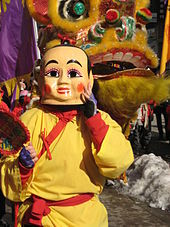
Nianhua can be a form of Chinese colored woodblock printing, for decoration during Chinese New Year.
Flowers
The following are popular floral decorations for the New Year and are available at new year markets.
Icons and ornaments
Spring travel

Traditionally, families gather together during the Chinese New Year. In modern China, migrant workers in China travel home to have reunion dinners with their families on Chinese New Year's Eve. Owing to the large number of interprovincial travellers, special arrangements were made by railways, buses and airlines starting from 15 days before the New Year's Day. This 40-day period is called chunyun, and is known as the world's largest annual migration. More interurban trips are taken in mainland China in this period than the total population of China.
In Taiwan, spring travel is also a major event. The majority of transportation in western Taiwan is in a north-south direction: long distance travel between urbanized north and hometowns in rural south. Transportation in eastern Taiwan and that between Taiwan and its islands is less convenient. Cross-strait flights between Taiwan and mainland China began in 2003 as part of Three Links, mostly for "Taiwanese businessmen" to return to Taiwan for the new year.
##Festivities outside China
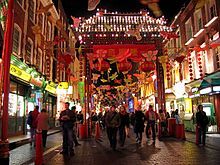
Chinese New Year is also celebrated annually in many countries with significant Chinese populations. These include countries throughout Asia, Oceania, and North America. Both London and San Francisco claim to host the largest New Year celebration outside of Asia and South America.
Southeast Asia
In some countries of Southeast Asia, Chinese New Year is a national public holiday and considered to be one of the most important holidays of the year. Chinese New Year's Eve is typically a half-day holiday for Malaysia and Singapore.
The biggest celebrations take place in Malaysia (notably in Kuala Lumpur, Penang and Klang) and Singapore. In Sabah, Malaysia, the Dusun Tatana in Kuala Penyu also celebrate Chinese New Year, mixed with traditional customs of the native population.
Chinese New Year in Singapore is accompanied by various festive activities. One of the main highlights is the Chinatown celebrations. In 2010, this included a Festive Street Bazaar, nightly staged shows at Kreta Ayer Square and a lion dance competition. The Chingay Parade also features prominently in the celebrations. It is an annual street parade in Singapore, well known for its colorful floats and wide variety of cultural performances. The highlights of the Parade for 2011 include a Fire Party, multi-ethnic performances and an unprecedented travelling dance competition.
Chinese New Year is considered to be the most important festival for Filipino-Chinese in the Philippines, and its celebration has also extended to the non-Chinese majority Filipinos. In 2012, Chinese New Year was included in public holidays in Philippines, which is only the New Year's Day itself.
Chinese New Year, officially named Tahun Baru Imlek, has also been celebrated by Chinese-Indonesians since 1999 after President Suharto stepped down. It was declared as a 1-day public holiday in 2003 and the other two days were unofficial Chinese New Year holidays, celebrated by all Indonesians (2 days) and Chinese Indonesians (3 days). Big Chinese population cities and towns like Jakarta, Medan, Singkawang, Pangkal Pinang, Bagansiapiapi, Selat Panjang, Batam, Ketapang and Pontianak always have its own New Year's celebration every years with parade and fireworks.
Australia and New Zealand
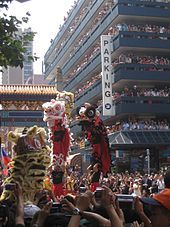
With one of the largest Chinese populations outside of Asia, Sydney also claims to have the largest Chinese New Year Celebrations outside of Asia with over 600,000 people attending the celebrations in Chinatown annually. The events there span over three weeks including the launch celebration, outdoor markets, evening street food stalls, Chinese top opera performances, dragon boat races, a film festival and multiple parades that incorporate Chinese, Japanese, Korean and Vietnamese performers. More than 100,000 people attend notably the main parade with over 3,500 performers. The festival also attracts international media coverage, reaching millions of viewers in Asia. The festival in Sydney is organized in partnership with a different Chinese province each year.
The city of Wellington hosts a two-day weekend festival for Chinese New Year.
North America
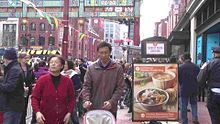 Play media
Play mediaMany cities in North America sponsor official parades for Chinese New Year. Among the cities with such parades are San Francisco, Los Angeles, New York City, Boston, Mexico City, Toronto, and Vancouver. However, even smaller cities that are historically connected to Chinese immigration, such as Butte, Montana, have recently hosted parades.
Multiple groups in New York City cooperate to sponsor a week-long Lunar New Year celebration. The festivities include cultural festival, music concert, fireworks on the Hudson River near the Chinese Consulate, and special exhibits. In June 2015, New York City Mayor Bill de Blasio declared that the Lunar New Year would be made a public school holiday.
California

The San Francisco Chinese New Year Festival and Parade is the oldest and largest event of its kind outside of Asia, and the largest Asian cultural event in North America.
The festival incorporates Grant and Kearny Streets into its street festival and parade route, respectively. The use of these streets traces its lineage back to early parades beginning the custom in San Francisco. In 1849, with the discovery of gold and the ensuing California Gold Rush, over 50,000 people had come to San Francisco to seek their fortune or just a better way of life. Among those were many Chinese, who had come to work in the gold mines and on the railroad. By the 1860s, the residents of San Francisco's Chinatown were eager to share their culture with their fellow San Francisco residents who may have been unfamiliar with (or hostile towards) it. The organizers chose to showcase their culture by using a favorite American tradition – the parade. They invited a variety of other groups from the city to participate, and they marched down what today are Grant Avenue and Kearny Street carrying colorful flags, banners, lanterns, drums and firecrackers to drive away evil spirits.
In San Francisco, over 100 units participate in the annual Chinese New Year Parade held since 1958. The parade is attended by some 500,000 people along with another 3 million TV viewers.
Europe
In London, the celebrations take place throughout Chinatown, Leicester Square and Trafalgar Square. Festivities include a parade, cultural feast, fireworks, concerts and performances. The celebrations attract between 300,000 and 500,000 people according to the organisers.
In Paris, the celebrations are held since the 1980s in several districts during one month with many performances and the main of the three parades with 40 groups and 4,000 performers is attended alone by more than 200,000 people in the 13th arrondissement.
Other parts of the world


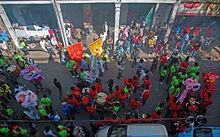
Many celebrate the festival in Chinatown, Kolkata, India where a significant community of people of Chinese origin exists. In Kolkata, Chinese New Year is celebrated with lion and dragon dance.
In Pakistan, the Chinese New Year is also celebrated among the sizable Chinese expatriate community that lives in the country. During the festival, the Chinese embassy in Islamabad arranges various cultural events in which Pakistani arts and cultural organizations and members of the civil society also participate.
##Greetings
The Chinese New Year is often accompanied by loud, enthusiastic greetings, often referred to as 祥瑞話 (jíxiánghùa) in Mandarin or 吉祥說話 (Kat Lei Seut Wa) in Cantonese, loosely translated as auspicious words or phrases. New Year couplets, printed in gold letters on bright red paper, are another way of expressing auspicious new year wishes. They probably predate the Ming Dynasty (1368–1644), but did not become widespread until then. Today, they are ubiquitous with Chinese New Year.
Some of the most common greetings include:
- simplified Chinese: 新年快活; traditional Chinese: 新年快樂; pinyin: Xīnniánkuàilè; Jyutping: san1 nin4 faai3 lok6; Pe̍h-ōe-jī: Sin-nî khòai-lo̍k; Hakka: Sin Ngen Kai Lok; Taishanese: Slin Nen Fai Lok. A more contemporary greeting reflective of Western influences, it literally translates from the greeting "Happy new year" more common in the west. But in northern parts of China, traditionally people say simplified Chinese: 过年好; traditional Chinese: 過年好; pinyin: Guònián Hǎo instead of simplified Chinese: 新年快活; traditional Chinese: 新年快樂 (Xīnniánkuàile), to differentiate it from the international new year. And 過年好 (Guònián Hǎo) can be used from the first day to the fifth day of Chinese New Year. However, 過年好 (Guònián Hǎo) is considered very short and therefore somewhat discourteous.
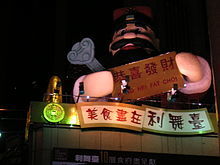 Gong Hei Fat Choi at Lee Theatre Plaza, Hong Kong
Gong Hei Fat Choi at Lee Theatre Plaza, Hong Kong - simplified Chinese: 恭喜发家; traditional Chinese: 恭喜發財; pinyin: Gōngxǐfācái; Hokkien: Keong hee huat chye (POJ: Kiong-hí hoat-châi); Cantonese: Gung1 hei2 faat3 coi4; Hakka: Gong Hei Fat Choi, which loosely translates to "Congratulations and be prosperous". Often mistakenly assumed to be synonymous with "Happy New Year", its usage dates back several centuries. While the first two words of this phrase had a much longer historical significance (legend has it that the congratulatory messages were traded for surviving the ravaging beast of Nian, in practical terms it may also have meant surviving the harsh winter conditions), the last two words were added later as ideas of capitalism and consumerism became more significant in Chinese societies around the world.[citation needed] The saying is now commonly heard in English speaking communities for greetings during Chinese New Year in parts of the world where there is a sizable Chinese-speaking community, including overseas Chinese communities that have been resident for several generations, relatively recent immigrants from Greater China, and those who are transit migrants (particularly students).
Numerous other greetings exist, some of which may be exclaimed out loud to no one in particular in specific situations. For example, as breaking objects during the new year is considered inauspicious, one may then say 歲歲安然 (Suìsuì-píng'ān) immediately, which means "everlasting peace year after year". Suì (歲), meaning "age" is homophonous with 碎 (suì) (meaning "shatter"), in demonstration of the Chinese love for wordplay in auspicious phrases. Similarly, 年年有餘 (niánnián yǒu yú), a wish for surpluses and bountiful harvests every year, plays on the word yú that can also refer to 魚 (yú meaning fish), making it a catch phrase for fish-based Chinese new year dishes and for paintings or graphics of fish that are hung on walls or presented as gifts.
The most common auspicious greetings and sayings consist of four characters, such as the following:
- 金玉滿堂 Jīnyùmǎntáng - "May your wealth [gold and jade] come to fill a hall"
- 大展鴻圖 Dàzhǎnhóngtú - "May you realize your ambitions"
- 迎春接福 Yíngchúnjiēfú - "Greet the New Year and encounter happiness"
- 萬事快意 Wànshìrúyì - "May all your wishes be fulfilled"
- 吉慶有餘 Jíqìngyǒuyú - "May your happiness be without limit"
- 竹報安然 Zhúbàopíng'ān - "May you hear [in a letter] that all is well"
- 一本萬利 Yīběnwànlì - "May a small investment bring ten-thousandfold profits"
- 福壽雙全 Fúshòushuāngquán - "May your happiness and longevity be complete"
- 招財進寶 Zhāocáijìnbǎo - "When wealth is acquired, precious objects follow"
These greetings or phrases may also be used just before children receive their red packets, when gifts are exchanged, when visiting temples, or even when tossing the shredded ingredients of yusheng particularly popular in Malaysia and Singapore. Children and their parents can also pray in the temple, in hopes of getting good blessings for the new year to come.
Children and teenagers sometimes jokingly use the phrase 恭喜發財,紅包拿來 (in Traditional Chinese; Simplified Chinese: 恭喜发家,红包拿来; Pinyin: gōngxǐfācái, hóngbāo nálái; Cantonese: 恭喜發財,利是逗來; English: usually written as Gong Hei Fat Choi or Kung Hei Fat Choy) roughly translated as "Congratulations and be prosperous, now give me a red envelope!". In the Hakka dialect the saying is more commonly said as 'Gung hee fatt choi, hung bao diu loi' which would be written as 恭喜發財,紅包逗來 – a mixture of the Cantonese and Mandarin variants of the saying.
Back in the 1960s, children in Hong Kong used to say 恭喜發財,利是逗來,斗零唔愛 (Cantonese, Gung Hei Fat Choy, Lai Si Tau Loi, Tau Ling M Ngoi), which was recorded in the pop song Kowloon Hong Kong by Reynettes in 1966. Later in the 1970s, children in Hong Kong used the saying: 恭喜發財,利是逗來,伍毫嫌少,壹蚊唔愛 (Cantonese), roughly translated as, "Congratulations and be prosperous, now give me a red envelope, fifty cents is too little, don't want a dollar either." It basically meant that they disliked small change – coins which were called "hard substance" (Cantonese: 硬嘢). Instead, they wanted "soft substance" (Cantonese: 軟嘢), which was either a ten dollar or a twenty dollar note.
